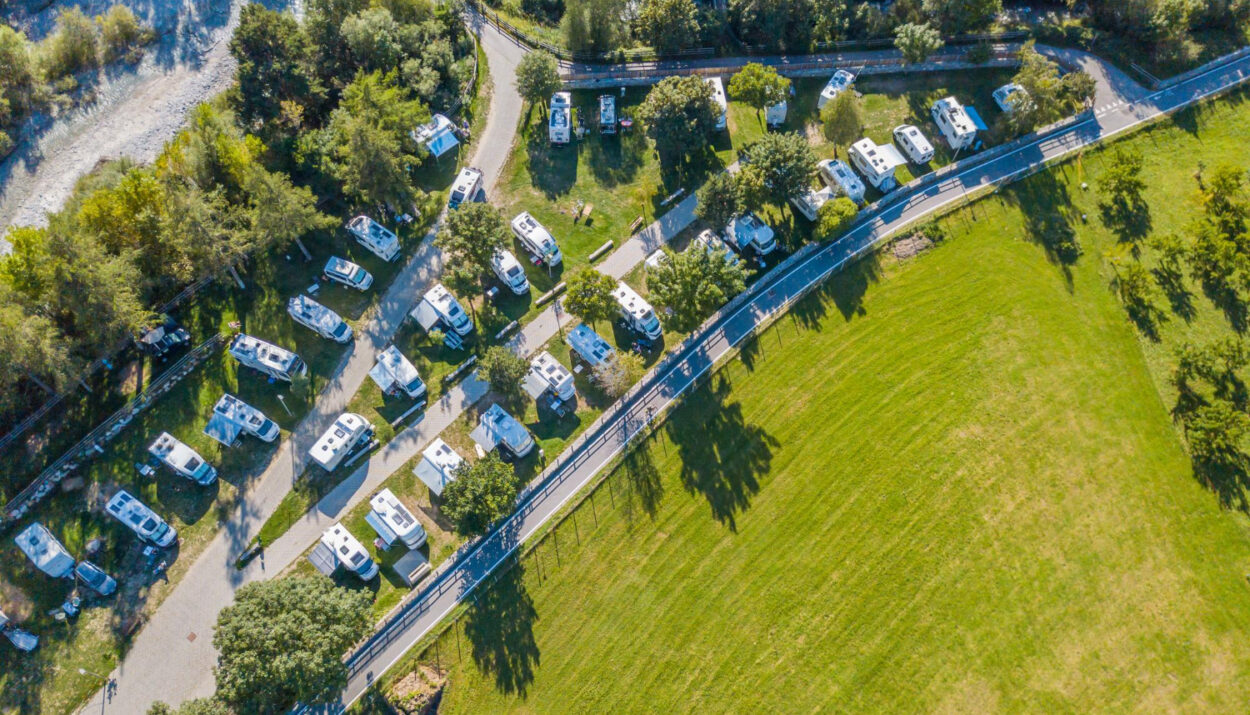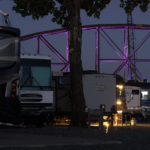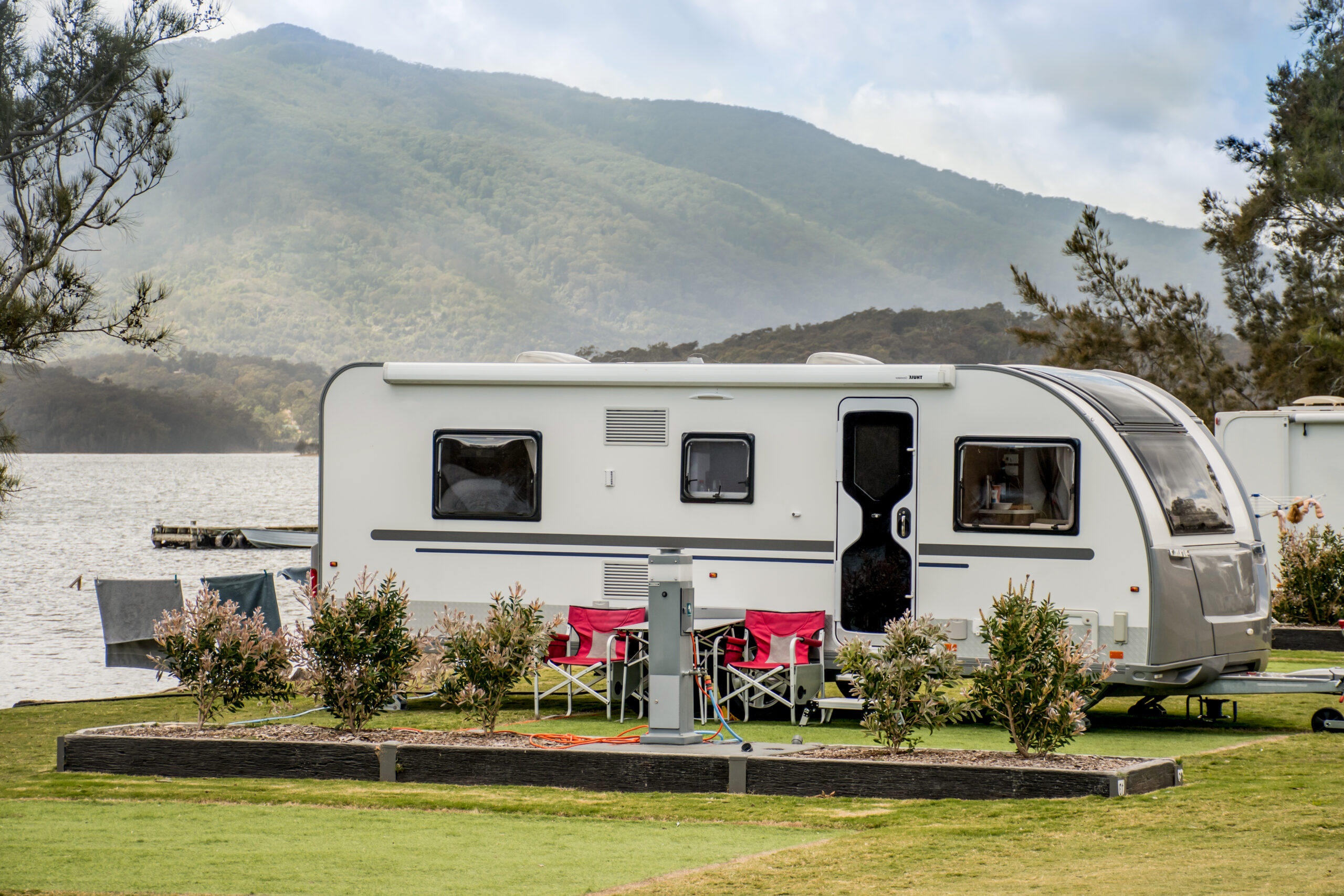Starting a campground is an exciting and rewarding business venture, but it begins with one of the most important decisions you’ll make—choosing the right size property. Your campground land size requirements will impact everything from the layout and zoning approvals to your guest experience, infrastructure needs, and room for future growth.
Whether you’re envisioning a quiet tent-only retreat or a full-scale RV resort with premium amenities, understanding how much land you need is crucial to planning a campground that’s functional, profitable, and built to last. In this guide, we’ll explore the key factors to consider so you can make informed decisions and set your business up for long-term success.
Key Takeaways
- The average campground needs at least 5–10 acres to be viable.
- Land requirements depend on amenities, site types, and your business model.
- Zoning laws and utilities access are critical factors when choosing land.
- Larger properties offer more flexibility and potential for growth.
- Starting small and expanding over time is a common and effective strategy.
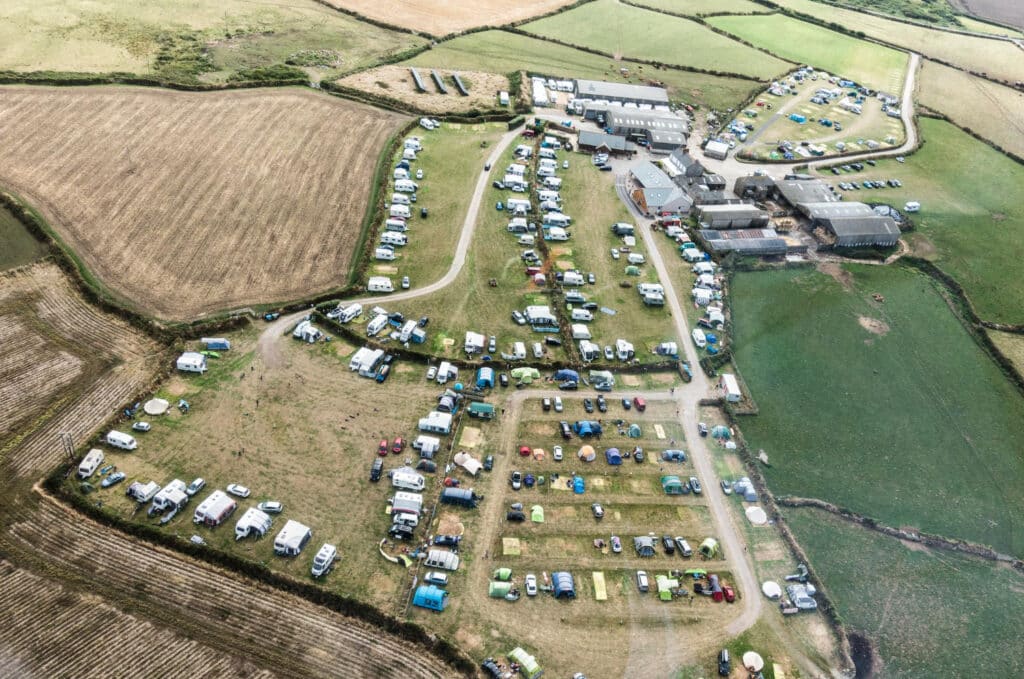
Why Campground Land Size Requirements Matter
The land you choose shapes your campground’s layout, guest capacity, infrastructure, and financial viability. It’s not just about squeezing in as many campsites as possible. Your acreage must accommodate a variety of elements beyond the individual campsites, including access roads, utility infrastructure, parking, recreation areas, and safety buffers.
Cramped campgrounds tend to receive lower reviews, experience more complaints, and may even violate zoning regulations. On the other hand, overly spacious layouts can create unnecessary costs and maintenance burdens, especially if those extra acres aren’t contributing to your revenue. A well-sized and well-planned piece of land supports a positive guest experience while streamlining operations and leaving room to grow.
Balancing Guest Experience with Operational Efficiency
Your guests are looking for more than a place to park or pitch a tent—they want comfort, privacy, and a smooth experience from arrival to checkout. When campsites are too close together, noise and lack of privacy quickly become problems. But when they’re too far apart, it can make amenities feel inaccessible and stretch your staff too thin.
Successful campground layouts provide just enough separation between sites to ensure comfort while maintaining easy access to shared facilities. Wide, navigable internal roads make movement effortless for both guests and service vehicles. Centralized amenities reduce the walking distance without sacrificing the peaceful feel of a natural setting. The goal is to build an environment where convenience and tranquility coexist, supported by a layout that your team can maintain efficiently.
Plan for Growth: The Value of Extra Acreage
While your initial plan may be modest, your campground should be designed with future phases in mind. Many owners launch with a small number of campsites and expand over time as demand and revenue grow. The cost and complexity of expansion are significantly reduced when you’ve already secured a parcel that supports future development.
Additional land allows for the later addition of cabins, glamping units, recreational amenities, or more campsites without disrupting existing operations. It also gives you flexibility to adapt as guest preferences and industry standards evolve. Starting with a property that gives you room to breathe and build ensures your business can stay competitive for years to come.
Minimum Land Requirements by Campground Type
Different RV campground types have different spatial needs. How much land you require depends on your accommodations, guest expectations, and operational model.
Tent-Only Campgrounds
Tent-only campgrounds are generally the most space-efficient. Each tent site typically occupies about 1,000 to 1,500 square feet, with extra space needed for restrooms, pathways, and gathering areas. You can fit a functional tent campground on as little as 2 to 3 acres, but most operators find that 5 acres or more creates a better experience and supports future improvements. Campers appreciate space, shade, and tranquility, which can’t be achieved in a cramped layout.
RV Parks with Full Hookups
RV parks require significantly more land per site due to the size of RVs and the infrastructure they demand. Each site may need between 1,200 and 2,500 square feet, plus additional room for driveways, utility corridors, and fire lanes. A small RV park with 20 to 30 sites generally needs 8 to 10 acres, while larger or higher-end parks may require 15 acres or more. Don’t forget to account for dump stations, laundry rooms, and wide roads that allow for large vehicle maneuvering.
Glamping or Cabin-Based Campgrounds
If your vision involves glamping tents, yurts, or cabins, plan for larger footprints. These luxury accommodations often include private bathrooms, decks, and scenic spacing between units, each requiring 2,000 to 5,000 square feet. Shared facilities, water and septic systems, and staff quarters add to the land requirements. A glamping-focused campground typically needs a minimum of 10 to 15 acres to offer a premium experience and support sustainable growth.
Mixed-Use Campgrounds
Mixed-use campgrounds that combine RV sites, tent camping, and glamping units are increasingly popular—but they also introduce greater complexity. You’ll need space for varied site sizes, distinct utility needs, and traffic patterns that accommodate all guest types. For this reason, most mixed-use campgrounds require 10 to 20 acres. A larger footprint gives you design flexibility, improves traffic flow, and allows you to strategically separate different guest areas without sacrificing cohesion.

Zoning, Access, and Infrastructure Considerations
Even if you’ve found the perfect plot in terms of acreage, it might not be ready for campground development. Local laws, environmental regulations, and infrastructure access play a huge role in determining what you can actually build—and where.
Zoning Laws
Zoning regulations vary widely by city, county, and state. Some areas may not permit campground use at all without a special use camping permit or zoning variance. Others may enforce minimum lot sizes, setback distances, or density caps that restrict how many sites you can build per acre. It’s essential to consult with local zoning authorities before purchasing land. Get written confirmation that campgrounds are a permitted use—or be prepared for a potentially long approval process.
Utilities and Infrastructure
Having the land is only one piece of the puzzle. Without access to utilities, development becomes more expensive and less efficient. If public water and sewer are unavailable, you’ll need to install private systems, which require additional space and government approval. Septic fields, well systems, and electrical service infrastructure all eat into your usable land. Land located near municipal services is ideal, but rural areas may require private wells, septic systems, and generators or solar power.
Planning ahead can save headaches. For example, ensure your layout leaves enough room for future septic expansion or backup generators. Think not only about current needs but also about how easily your utility systems can scale with your business.
Road Access and Traffic Flow
Your campground must be accessible via safe, public roads that can handle trailers, fifth wheels, and buses. If the land is isolated or lacks a developed entrance, you may need to invest in grading or right-of-way access improvements. Once guests enter your property, they’ll need internal roads that accommodate two-way traffic, emergency vehicles, and easy navigation.
Calculating Your Campground’s Spatial Needs
After identifying your campground type, infrastructure needs, zoning ordinances and all the proper permits, the next step is to calculate how much land you’ll actually need. Start by estimating your average site size. RV sites typically need 1/8 to 1/4 acre, while tent sites are smaller. Multiply the number of planned sites by the average square footage required, and then add additional land for roads, utilities, recreation areas, and buffer zones.
It’s common for infrastructure and shared facilities to consume an extra 25 to 40 percent of your total land. Don’t forget about parking, especially for visitors who may not be staying overnight. Even small things—like the space needed for trash collection areas or maintenance buildings—can add up quickly.
A well-designed site plan that includes both private and shared areas will ensure your campsite feels spacious and welcoming without wasting land that could drive revenue.

Tips for Choosing the Right Property
Armed with a clear understanding of campground land size requirements, zoning considerations, and infrastructure needs, you’re ready for one of the most critical steps in the entire process: choosing the right piece of land. This decision lays the foundation for your future campground’s layout, guest experience, and scalability. While your budget will naturally influence your options, long-term viability should always take precedence over short-term savings.
The best campground properties offer more than just acreage—they provide strategic advantages that can save you time, money, and frustration during both development and operation. Here’s how to make a smart, informed decision when selecting your property.
Start Small, but Think Big
Most successful campgrounds begin with a limited number of sites—usually 10 to 20—to test operations, build guest loyalty, and minimize upfront risk. Starting small allows you to fine-tune your layout, understand seasonal demand, and invest gradually in amenities and staff. But from day one, choose a property with room to expand. Even if you’re only developing a portion initially, the ability to grow into your land is key to long-term success.
So, when should you consider expanding? Look for these signs:
- 70–80% occupancy during peak season, especially if you’re turning guests away
- Waitlists on holiday weekends or high-demand periods
- Stable cash flow and manageable day-to-day operations
- Strong guest reviews and a growing base of repeat visitors
- Frequent inquiries for accommodation types you don’t yet offer, like cabins or group sites
- Utility systems built with scalability in mind, such as oversized septic or road layouts
Expansion doesn’t always mean more campsites—it could mean diversifying with glamping units, group areas, or premium amenities. Use demand and operational performance as your guide, and always design with the next phase in mind.
Understand the Topography and Soil Conditions
Not all acres are created equal. A 10-acre property with level ground and good drainage can be far more usable—and affordable to develop—than a 20-acre parcel that’s steep, rocky, or partially covered by wetlands. Before you make an offer, walk the property and observe how water moves across the land after rainfall. Look for signs of erosion, standing water, or dense vegetation that might indicate soggy or poor-draining soil.
A topographic survey is one of the most valuable investments you can make in the early stages of property evaluation. It will help you determine how much of the land is actually buildable and what kind of grading or soil stabilization might be required. Clay-heavy soil, for example, can complicate septic installation, while steep slopes can drive up the cost of road construction or make it impossible to install RV sites.
Ideal campground land features a mix of open areas and light tree cover, with good drainage and minimal need for heavy excavation. Bonus points if the property has existing access to utilities or attractive natural features like a stream, hilltop view, or wooded grove—these can all become part of your value proposition to guests.
Prioritize Accessibility and Location
While remote locations can offer a peaceful, off-the-grid experience, they often come with challenges that make development more expensive or complicated. Ensure the property is accessible via public roads that are suitable for trailers and large vehicles. Avoid locations where steep driveways, sharp turns, or unpaved access points could discourage guests from returning—or prevent emergency services from reaching your campground quickly.
Proximity to population centers, natural attractions, and highways can also impact your marketing strategy and guest volume. Campgrounds near national parks, lakes, or travel corridors tend to perform well due to higher visibility and convenience. Even rural destinations can succeed if they’re positioned as a getaway for nearby urban dwellers. Consider how easily guests will be able to find your property and whether they’ll need to travel long distances on rough or confusing roads.
Do Your Legal and Environmental Due Diligence
Before finalizing a land purchase, conduct a thorough title search to confirm property boundaries, easements, and legal access. Make sure there are no liens or encumbrances that could delay development. If the land is part of a subdivision or homeowners’ association, review any covenants or restrictions that could limit your ability to operate a commercial business.
Environmental due diligence is equally important. Some properties may contain protected habitats, endangered species, or wetlands that prevent development in certain zones. You may also need to conduct soil percolation tests to determine if a septic system can be installed, or an environmental site assessment to check for contamination if the land was previously used for industrial or agricultural purposes.
Taking shortcuts at this stage can lead to major delays or expenses later. Even if the land looks perfect on the surface, hidden legal or environmental issues can derail your project before you break ground.
Work With Experts from the Start
Don’t try to navigate land selection on your own. Engaging professionals early in the process can save you from costly missteps and help you get the most out of your investment. A campground consultant, land planner, or civil engineer can provide invaluable insight on how to assess property viability, estimate infrastructure costs, and design an efficient site layout.
These experts can also help you understand what’s realistically possible within your timeline and budget. They’ll identify red flags, propose creative design solutions, and help you avoid common pitfalls that many first-time campground owners encounter.
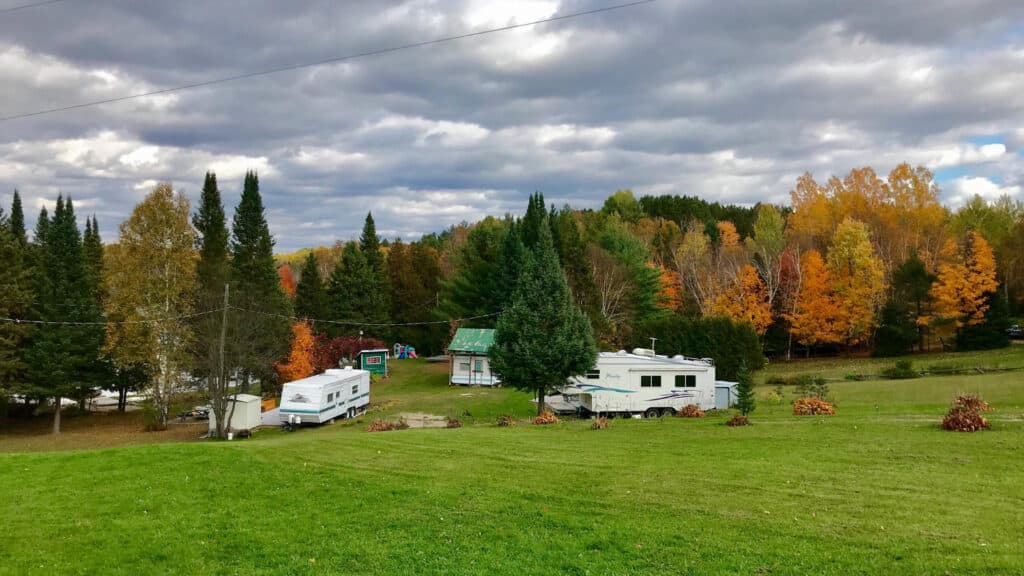
Plan Smart, Build Smarter
Understanding campground land size requirements is one of the most important steps in building a successful outdoor hospitality business. The right property gives you the flexibility to serve your guests well, run efficient operations, and grow in the future. Don’t rush into a purchase without researching zoning laws, utility access, road conditions, and long-term viability.
Take the time to do your due diligence, plan your layout strategically, and consider how your campground might evolve over time. Whether you’re starting with five campsites or fifty, thoughtful planning today ensures you’ll be ready to meet tomorrow’s demand.
And When You’re Ready to Open…
Once you’ve secured your land and started development, it’s time to think about how you’ll manage reservations, payments, and guest communications. A campground reservation software like RoverPass can streamline all of this, saving you time while boosting bookings. RoverPass helps you manage online reservations, track occupancy, automate check-ins, and connect with campers—all from one easy-to-use platform. It’s built specifically for campgrounds and RV parks, making it the perfect partner as you turn your dream property into a thriving business.
Frequently Asked Questions
1. How many campsites can fit on 1 acre of land?
The number of campsites you can fit on 1 acre depends heavily on the type of site, spacing regulations, infrastructure layout, and local zoning requirements. On average, a well-planned acre can accommodate 4–8 RV sites with full hookups, assuming each site takes up 1/8 to 1/4 acre including access roads, buffers, and utilities. Tent sites are more compact, allowing for 10–15 sites per acre if designed efficiently and without dense amenities. However, this is just a baseline—when you factor in additional land for internal roads, communal facilities, setbacks, and fire safety codes, the actual usable density often decreases.
2. Do I need to own the land outright to start a campground?
No, you don’t have to own the land outright to launch a campground, though owning does offer more flexibility and long-term benefits. Many campground owners start by leasing land or entering into a lease-to-own agreement, especially if they’re testing a market or working with a limited budget. If you do lease, make sure your contract includes clauses that allow for infrastructure investment, insurance coverage, and multi-year stability. You’ll need long-term security if you’re going to invest in septic systems, utilities, or structures. Ownership, while more capital intensive upfront, gives you more control over land use, resale value, and future development.
3. How long does it take to develop raw land into a campground?
The timeline for developing raw land into a functional campground ranges from 6 to 18 months, depending on a variety of factors including location, property condition, weather, permitting, and the complexity of your build. The early stages—due diligence, site planning, and permitting—often take the longest. Securing approvals from zoning and environmental agencies can require several months, especially if you need to apply for variances or special use permits. Once you have permits in hand, construction typically takes 3–9 months, depending on the size of the campground and whether you’re building in phases.
4. Can I build a campground in a floodplain or wetlands area?
Building a campground in a floodplain or wetlands area is heavily regulated and often discouraged. In many states, construction in designated flood zones requires special permits and elevated structures to meet FEMA and local building codes. These areas are prone to seasonal flooding, which can damage property, create insurance complications, and deter guests. Wetlands are protected by federal and state environmental laws, and any development typically requires approval from agencies like the U.S. Army Corps of Engineers. Even minor alterations, such as grading or installing utility lines, can trigger costly mitigation requirements.
5. What kind of insurance do I need for my campground?
A campground requires several types of insurance to operate safely and legally. At a minimum, you’ll need general liability insurance to protect against accidents, injuries, or property damage involving guests. Most policies cover incidents like slip-and-falls, fire damage, or damage to vehicles caused by trees or falling debris. You’ll also need property insurance to cover buildings, utilities, and amenities like restrooms, laundry facilities, and recreational structures. If you rent or store RVs, offer guided activities, or have a pool, additional specialized coverage may be required. Consider business interruption insurance to protect your income in case a natural disaster or other event forces a temporary closure.

